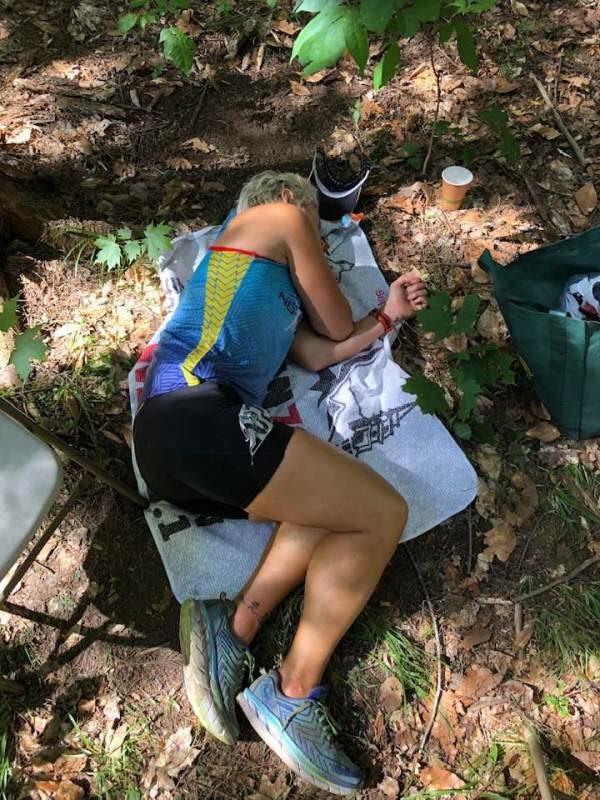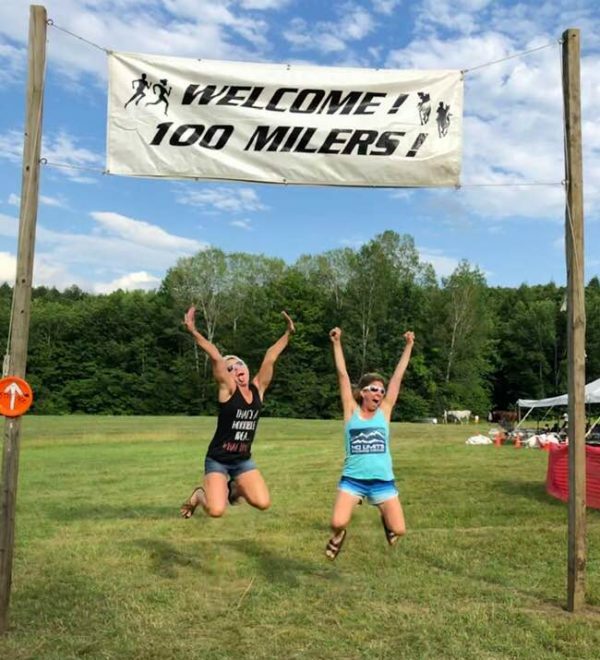
I had so many reasons to quit the Vermont 100 Endurance Run, and reasons I knew were good enough and people would support me. I had trench foot, a strained calf, blisters covering my feet, and a series of other maladies. But I continued on, aid station to aid station, and I cannot be more grateful and proud that I did not give in to those voices telling me to stop.
Vermont 100 Endurance Run: boy, you did not disappoint. My goals going into this race were to push my limits higher, to dig deeper than I have before, and to test those mental boundaries. Check, check, and check.
I registered for Vermont 100 back in January, when my 100 mile buddies, Maria and John, registered. I did Ironman Texas in April, figured I could recover out of that and have a good base before transitioning to ultra training. Maria, my coach, and I knew it’d be a little tight, but thought it was achievable. This was my second 100 miler, with Umstead being my first last year.
I recovered well after Ironman Texas. Then on my first trail run in May, my left ankle, which I’ve sprained a bazillion times, got very cranky. I figured, no biggie, it just needed some rest, so I took the week off from running. But every time I tried to get back to running, it got really painful again. I pushed through Connecticut 70.3 on my sore ankle, then went to our Lake Placid training camp the following weekend where I proceeded to strain my calf on hill repeats (likely from compensating for my ankle).
So I was off running for two weeks, and even walking was out because that was irritating my calf. After that time off, my ankle was still not better, so I finally went to Physical Therapy with Scott McGeary at Pivot (an elite runner himself who specializes in runners) and he fixed me almost immediately with some strengthening and stability exercises for my ankle. I wish I’d gone to him a month prior!
I was finally back to running, about 2.5 weeks out from VT (yikes!). So, those last few weeks were great – got out to the trail, got a few longer runs in, but yeah…it’s a freaking 100 miler. I knew doing mostly bike and swim training was not ideal.
Vermont 100 has 17,000 ft of elevation gain and drop, with a mix of 30 miles of trail, 68 miles of rolling dirt roads, and 2 miles of road. You are either going up or down the entire race. That is more than 2x as much vertical change as Umstead has, which I had been well trained for, completing 95% of my training with several weeks of over 70 miles of running. Of course, I was a bit worried about how this would go with my lack of run training and the much more difficult course.
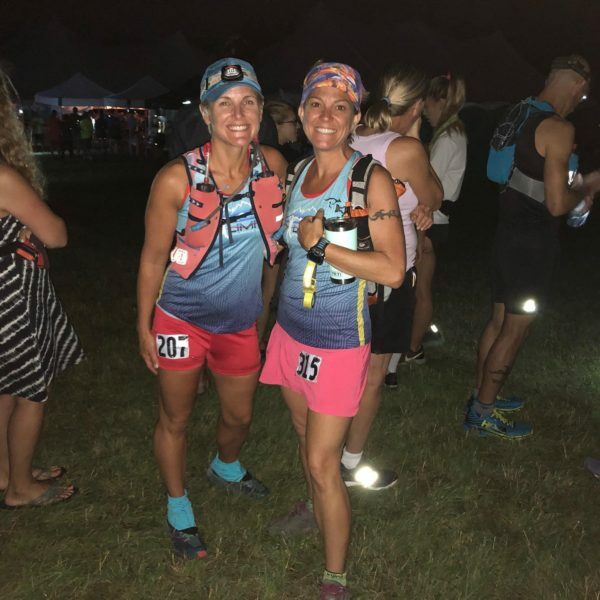
And then the forecast came in – high of 97 degrees but with the feel of 106 degrees with the humidity. That would surely slow everyone down, and I didn’t need help being any slower. But I knew I’d need to manage my effort and pace in the heat to be able to finish.
Maria and I planned to run together for as long as possible, agreeing that whoever needed to eventually drop off would do that and stay within themselves. We stayed together for about 25 miles, which were the fastest miles, both mentally and by time, for me. We chatted with so many friendly runners along the way, and caught up with each other on everything from coaching to life.
My heart rate was bumping into zone 3 on the uphills trying to stay with Maria so I told her I needed to hang back. The heat was likely raising my heart rate higher, but also my lack of training was showing up.
I continued on my own, but began having some rough patches by mile 30. I kept moving forward as quickly as I could but my body was already beginning to feel my lack of training – those uphills were steep and LONG, training I had not done much of. One thing that was going really well, and continued going well the entire day was my fueling, hydration, and management of the heat. I stuck to my customized Infinit run formula, which provides calories and electrolytes, water, clif bloks, and small pieces of soft pretzel. I also grabbed watermelon at some aid stations. I carried 102 oz of fluid with me on my hydration pack (2 bottles and a bladder), which may seem excessive, but I’m so glad I did that because I always had plenty with me, and at every aid station I filled my cut up nylons with ice and wrapped them around my neck and/or waist (genius, Maria!).
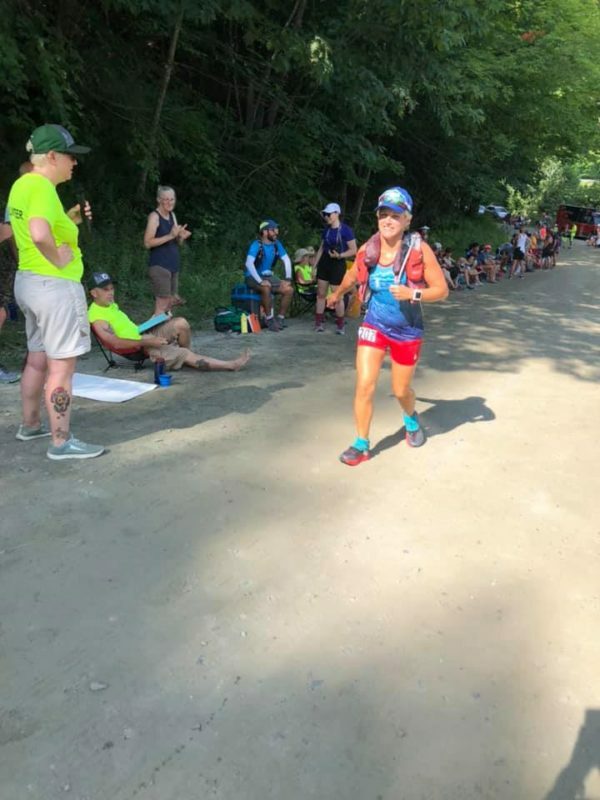
By Mile 40, I was done – I laid down in the grass at one point and stretched out my cranky calf I’d strained a month ago, thinking it was only going to get worse and I’d tear it if I’d continued on. I had resolved in my head that dropping was the smartest and best option. My feet were also becoming an issue.
But, thankfully, the counter voices chimed in, saying, “You bought those VT100 shirts for the kids and yourself, you can’t wear them if you don’t even finish!” and “I don’t want to have to do another 100 miler to get my Western States ticket this year!”
I hit an aid station at mile 43 and sat next to a woman, Miriam, who was also having injury issues with her ITB. A little girl working the aid station asked if I wanted some ibuprofen, and I said “sure”. I thought my race was just about over anyway (I’d see my crew at Camp 10 Bear at mile 48 and could drop then). I took the pills, and continued on. Before I knew it, I was trotting along again, feeling ok. The drugs took the edge off and got me through the hump.
Miriam came up beside me and asked how I was feeling, and surprised when I checked in with myself I answered, “Better… how about you?” She said, “Much better! Did you take drugs?” We then discussed how we didn’t really want to be taking the Advil because of the health risks during endurance events but were thankful to be running again. She was great company and we agreed that our new plan was to run aid station to aid station, and reassess at each one. And after we got to Camp 10 Bear, we’d only have to run another 22 miles before picking up our pacer. Easy, right? I resolved after that I’d continue on no matter what, and the only way I’d quit was if I missed a cutoff, and I’d need to be removed from the course by someone else, not myself.
I arrived at mile 48, Camp 10 Bear, met my pacer, Jeff, who was working the station and who I’d later pick up at mile 70. He was great and helped Dee Ann, my good friend crewing me, get what I needed – bladder filled, etc. I can’t remember when I first noticed my feet turning white and wrinkly – if it was at this aid station or before, but at this one I did a shoe change since my shoes and socks were soaked after the stream crossing at mile 38. Then onward I went.
My feet were becoming more painful as I went on, which I fully expected after my experience at Umstead 100 last year – my feet were so achy and painful for a lot of the race. But this felt a bit different – every step was feeling like pins and needles, and by the later miles, like prickly razor blades at some points.
Sounds awesome, right?
At every aid station I’d take my socks off and rub lube all over my feet. I also had gaiters on to keep the small rocks and sand out, which was great for that but it also trapped the moisture in my feet. By mile 65, I knew something was wrong and I stopped at an aid station and removed my socks and shoes and saw that my feet were completely white and wrinkled.
I yelled out to the volunteers, “Does anyone know anything about trench foot?” A man came over and looked at my feet and said, “Yep, you have the early stages of trench foot and you need to take care of that. Lay off the lube, that’s trapping moisture, and take off the gaiters. When you see your crew in 5 miles, you need to let the feet air out for at least 10 minutes. You need to take care of your paws. Trench foot can cause lifelong foot pain and neurological conditions.”
Wait, whaaaaat???!!!
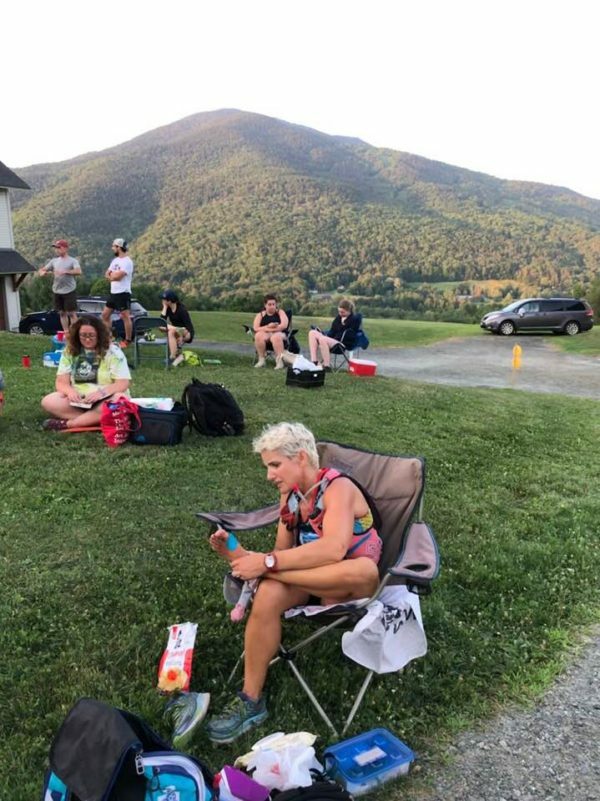
The first I’d heard of trench foot was at Umstead 100, where we ran in pouring rain for the duration of the race. For those of you who aren’t familiar with it, it’s a medical condition caused by prolonged exposure of the feet to damp, unsanitary and cold conditions and associated with WWI where many soldiers suffered from it. But I had no idea it could cause life-long issues.
How was it possible that I did not get it at Umstead, but was getting it here in VT? (I learned later that it’s very common at VT because of the humidity). So, this was my second closest time to dropping – I planned to go into Camp 10 Bear at mile 70 and have medical check me out and if they told me to stop, I absolutely would – I wasn’t risking any life-long condition for one race, nope. “Live to run another day” as coach Maria says. And I’m a mom and a coach first, then an athlete. It was dark by now, and those 5 miles were long ones with every foot step excruciating.
When I got to Camp 10 Bear, Jeff immediately met me, followed by Dee Ann, and, wide-eyed, I said, “We need to take care of my feet, NOW!”
I sat down and removed my socks and shoes and Dee called over an EMT to check my feet out. He assured me I’d be ok if we took the time to dry out my feet, so that’s what we did. Jeff immediately took on crew/pacer responsibilities, popping a few huge blisters on my feet and airing out my feet by fanning them. We got close quickly. After about 10 minutes my feet came around and gained color again. I put on my third (!) pair of shoes, which were road shoes, but were dry. I was ready to roll.
Jeff and I took off and I was feeling optimistic and again feeling like I may finish. Leaving Camp 10 Bear the second time was just as challenging as the first – we had a lot of climbing, but this time on trail. I was so thankful to have Jeff guiding me because on my own I would’ve been very slow navigating that section. Jeff was great, chatting away, asking me what my favorite spice was, did I have dogs, etc. He was funny, crazy, motivating, a distraction from the pain…exactly what I needed. I remember getting into one aid station and Dee Ann asking, “Are you two getting along?” And Jeff replying, “Oh yeah, we got close quickly, we’re already blood brothers.”
I continued to make every aid station my goal. Those last 30 miles were LONG and SLOW and the feet were still very painful. I kept negating the voices in my head with, “Those pins and needles in the feet feel good! It’s like acupuncture, yes!”
The climbing never lets up on this course. I never thought I’d be thinking about the cut off times but all of a sudden we were. We got to Bill’s aid station at mile 88, and after working so hard to get there, the one volunteer told us we had to stay focused and keep moving to make it to Polly’s by the cut off. I also remember a volunteer there looking me in the eyes, saying how proud I should be for getting there and that already over 50% of the field had dropped. I remember feeling almost weepy when he said it to me because I’d been fighting for so long. I appreciated his kindness when I was feeling so rough.
I had to work HARD to make it to Polly’s at mile 96.6, and Jeff kept close watch of the time and what pace we had to keep. He was a good mix of being a cheerleader and being firm. I gave it everything I had to get there – hiking hard uphills and trotting down the hills when all my body and feet wanted to do was lay down. Every step continued to be excruciating for me, and stopping at aid stations made the pain worse. If I sat down, even for a minute to go to the bathroom, my feet felt 10 times worse when I started back up.
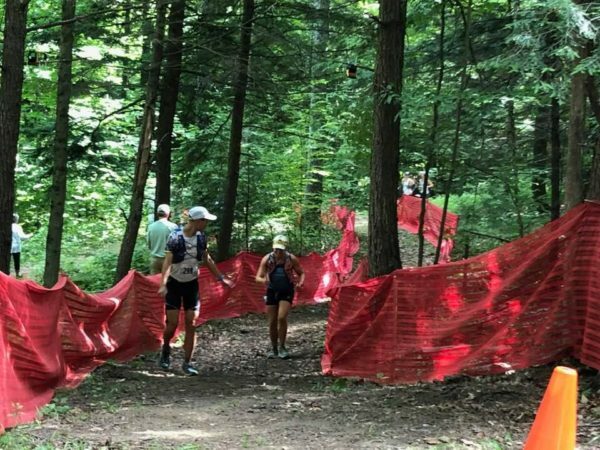
After making it to Polly’s, we only had 3.4 miles to go to the finish. Those were the longest 3.4 miles of my life. Jeff said, “Your freaking Boston Terrier, Polly, can do this, let’s go!!!” And I just couldn’t. The fastest I could go was a power walk, and it sure wasn’t very powerful. But I made it, with a measly 11 minutes to spare of the 30 hour cutoff, in 29:49 hours. There were only 152 finishers for the 100 mile, over 52% of the field dropped. I still cannot believe I made it to that finish line with how I felt through those 100 miles. I don’t think I would have believed it if someone had told me I’d finish when I was at mile 30.
100 milers are not solo endeavors – I am 100% confident I would not have finished this without my crew, Dee Ann Murphy, and my pacer, Jeff LeBlanc. I am forever grateful to them. I am also grateful to my husband for supporting me on these crazy races and through the training, and for my parents for watching the kids while I was away (even though they also think I’m crazy). And to my coach, Maria – the training for this sure did not go as planned, but we focused on what I COULD do (swimming, biking, strength training) and she gave me the confidence and support that I could still do the race on the little run training I had under me.
